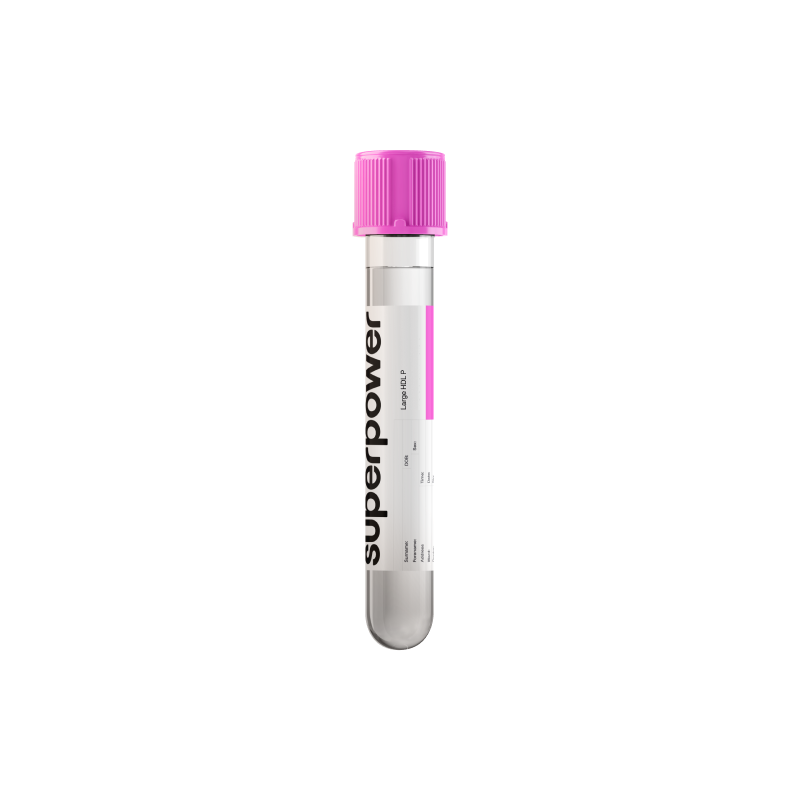Large HDL P testing shows how many of the larger, cholesterol-rich HDL particles you carry—particles that do the heavy lifting of reverse cholesterol transport. Unlike HDL-C, which only measures cholesterol cargo, Large HDL P counts the vehicles themselves.
This gives a clearer view of HDL quality, insulin resistance patterns, and how lifestyle, hormones, and training shape your lipid profile.
Key Benefits
- See your level of large, protective HDL particles that clear cholesterol.
- Flag hidden heart risk when HDL cholesterol seems normal but particles are low.
- Clarify metabolic health; low large HDL-P often accompanies insulin resistance and high triglycerides.
- Guide lifestyle priorities; raise activity, improve diet, and reduce weight to boost levels.
- Support treatment decisions when risk is borderline by refining risk beyond HDL cholesterol.
- Pair with apoB, LDL-C, and triglycerides to sharpen overall cardiovascular risk.
- Track progress; levels typically improve with exercise, weight loss, and lower triglycerides.
- Explain residual risk on statins; low large HDL-P may signal remaining risk.
What is Large HDL P?
Large HDL P is the number of large high‑density lipoprotein particles circulating in your blood. HDL are tiny packages of fat and protein (lipoproteins) made primarily by the liver and intestine. They start as small, lipid‑poor particles and grow as they pick up cholesterol from tissues. With help from remodeling enzymes (LCAT, hepatic lipase) and transfer proteins (CETP), these particles become mature, cholesterol‑rich HDL. Their main scaffold protein is apolipoprotein A‑I (apoA‑I). Large HDL P, then, summarizes how many of these mature, larger HDL particles are present.
In the body, large HDL particles act as couriers and platforms. They carry cholesterol away from peripheral tissues toward the liver (reverse cholesterol transport) via selective uptake pathways (SR‑BI) or by exchanging lipids with other lipoproteins. They also transport protective enzymes and signaling molecules (for example, paraoxonase‑1 and LCAT) that help stabilize lipids and support vascular health. Large HDL P reflects the pool of mature HDL capable of transporting cholesteryl esters, buffering excess lipids, and interacting with the vessel wall—capturing an aspect of HDL quantity and structure beyond simply how much cholesterol HDL contains.
Why is Large HDL P important?
Large HDL P is the count of the larger, more mature HDL particles that shuttle cholesterol out of vessel walls back to the liver and carry enzymes that quiet inflammation and protect the endothelium. Because HDL circulates between arteries, liver, fat, and steroid-producing tissues, this measure reflects cardiometabolic health, hepatic function, and immune tone all at once. On most assays, risk tends to be lower when values sit in the middle-to-upper part of the reference range; “higher is better” has limits, as extremely high readings are not always protective.
When this measure is low, HDL is often shifted toward small, triglyceride-rich particles seen with insulin resistance and elevated VLDL. Reverse cholesterol transport slows, antioxidant capacity drops, and vascular inflammation can rise. People may not feel symptoms, but it commonly travels with abdominal adiposity, higher triglycerides, rising glucose, and fatty liver biology. Men and postmenopausal women are affected more often; during adolescence, boys tend to have lower levels than girls.
When it is high within typical bounds, it signals plentiful, functional HDL with better cholesterol efflux, lower triglyceride exchange, and a calmer inflammatory milieu. Very high values, however, can accompany genetic variants, thyroid or liver conditions, or heavy alcohol exposure; in these settings, HDL can be abundant but less effective.
Big picture: Large HDL P integrates with triglycerides, apoB-containing particles, glucose–insulin signaling, thyroid and liver function. It complements, but is not interchangeable with, HDL cholesterol. In the long run, favorable levels align with healthier endothelial function and lower atherosclerotic risk, provided the particles are functional, not just numerous.
What Insights Will I Get?
Large HDL-P measures the concentration of large high-density lipoprotein particles in blood. These mature, cholesteryl-ester–rich HDL help move cholesterol out of tissues (reverse cholesterol transport), buffer oxidative and inflammatory stress, and reflect coordination between liver metabolism, endocrine signals, and immune tone. Levels mirror triglyceride handling, insulin sensitivity, and activity of LCAT, CETP, and hepatic lipase.
Low values usually reflect a triglyceride-rich, insulin-resistant state that remodels HDL toward smaller particles. Increased CETP exchange and hepatic lipase activity deplete cholesterol from HDL and blunt maturation. Inflammation or illness can lower ApoA‑I and LCAT activity. Men and postmenopausal women often run lower; late pregnancy with high triglycerides can reduce large HDL-P.
Being in range suggests effective HDL maturation and cholesterol efflux, with lower VLDL flux and balanced lipid traffic between liver and peripheral tissues. This pattern aligns with cardiometabolic stability and less vascular inflammation. Consensus generally places optimal toward the mid-to-higher end of a lab’s range when triglycerides and apoB are also favorable.
High values usually reflect efficient esterification and low triglyceride exchange, often seen with higher HDL‑C and good insulin sensitivity. Marked elevations can occur with genetic or drug-induced CETP inhibition, hypothyroidism, or strong estrogen exposure (e.g., early pregnancy). Very high levels from such causes may not add proportional vascular benefit.
Notes: Results vary with fasting status, current triglycerides, inflammation, thyroid or liver dysfunction, and medications (estrogens, androgens, CETP inhibitors, niacin, fibrates, statins). NMR subclass methods differ by lab; compare serial results within the same assay and alongside total HDL‑P, HDL‑C, triglycerides, and apoB.



.svg)



.png)
.png)
.png)
.png)









.png)